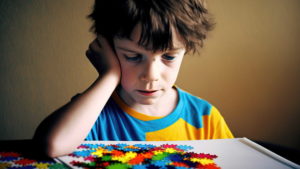Autistic Spectrum Disorder is a series of brain disorders that make it difficult for people to interact with others, to repeat the same actions again, and to have a narrow range of interests. It is like having numerous sizes and colors. Some ASD sufferers may require a lot of assistance, such as carrying an umbrella in the rain. Some people might not require any assistance at all and can complete tasks on their own.
Therefore, it appears that each person with Autistic Spectrum Disorder is unique, with some requiring more assistance than others.
It may be difficult for people with ASD to communicate and express their emotions to others. They might repeatedly wave their hands or repeat sentences, among other repetitive behaviors. They might have a strong desire to accomplish things they really, truly adore.
Nonetheless, here the most important thing is to understand that being unique is acceptable. Some adults with ASD go on to lead fulfilling lives as independent adults. It’s okay if some people need more assistance than others.
Everyone, even those with neurodevelopmental condition Autistic Spectrum Disorder, should attempt to be kind and make the world a welcoming place. Everyone will feel content and included in the process.
There is diversity in this world and some people are beautiful and different. Therefore, it is wise to understand the difference and be kind and understanding.
It is simple that people with ASD have their brain functions slightly different.
All individuals with ASD are unique thus; making things better would be incredible for them. Everyone will feel happy and included in the process.
Therefore, let us all understand the Autistic Spectrum Disorder.
What Is Autism Spectrum Disorder?

The term autistic spectrum disorders (ASD) refers to a collection of neurodevelopmental diseases that are categorized by difficulties in social communication, the occurrence of repetitive activities, and constrained interests. It is wise to understand that ASD is a spectrum disorder, which means that people with ASD can have a range of strengths and impairments. While some people may need a lot of support, others might be very independent.
Autism affects about 1 in 100 children. This point shows that one child out of every 100 may be autistic.
Neurodevelopmental condition Autism Spectrum Disorder frequently has early warning symptoms, but it can often go undiagnosed until a kid is older.
Autism affects people differently. Some people are able to live alone, whilst others require constant assistance from others due to their greater challenges.
Autism Spectrum Disorder: Symptoms and Signs
Social Difficulties: People with Autistic Spectrum Disorder may find it challenging to understand and react to social cues. They could have trouble keeping eye contact, expressing their feelings, or having meaningful conversations with others.
Communication impairments: Communication impairments frequently show up as slow language development, stuttering, or trouble with nonverbal cues like gestures and facial expressions.
Repetitive Behaviors: Repetitive behaviors include firmness on routines or services as well as repetition of certain gestures or acts (such as hand flapping or rocking).
Restricted Interests: Many people with Autistic Spectrum Disorder show intense, narrow interests in particular subjects or things, frequently to the exclusion of other hobbies.
Sensitivity: Increased or decreased sensitivity to sensory stimuli, such as sound, light, or touch, is a common symptom of ASD.
Diagnosis
The procedure of diagnosing Autistic Spectrum Disorder is difficult and evaluations are carried out by medical specialists, such as developmental pediatricians, child psychologists, and speech therapists. The process often includes:
- Learning about the developmental stages of a child and actions and collecting the developmental history
- Observing the behavior and interactions of children in diverse contexts as behavioral observation
- The use of regular examinations to evaluate cognitive abilities, social relationships, and language and communication abilities
- Interviews with parents and other caregivers to learn more about the child’s development and behavior
- Diagnostic guides like the DSM-5 (Diagnostic and Statistical Manual of Mental Disorders, Fifth Edition) include detailed criteria that are used to make diagnoses.
Options for Treatment of Autism Spectrum Disorders
Mental Health Services: Behavioral interventions like Applied Behavior Analysis (ABA) aim to target certain habits and impart new abilities. Communication, social engagement, and adaptive behaviors are all enhanced by ABA.
Medication: While there is no known cure for autism, doctors may prescribe medication to treat some symptoms including anxiety, anger, or hyperactivity. Decisions about medications should be carefully considered in light of each person’s needs and any potential negative effects.
Alternative and Complementary Therapies: Some Autistic Spectrum Disorder sufferers gain from complementary therapies such as sensory integration therapy, dietary modifications, and animal-assisted therapy. Before pursuing such treatments, it is imperative to seek advice from medical authorities.
Assessment and Treatment of Autism in Individuals
Early Intervention: Early intervention programs prioritize correcting developmental delays and offering therapy that is specialized to a child’s requirements. They are frequently started during the preschool years. Early intervention can greatly enhance results.
Support for Education: Individualized Education Plans (IEPs) and special education services enable children with ASD to gain access to the right educational materials and assistance. These programs are crucial for adjusting a child’s education to suit his or her individual needs.
Training in Social and Communication Skills: Social skills training programs show people with ASD how to interact with others, read social signs, and have meaningful discussions. The improvement of social interactions depends on these programs.
Risk Factors Of Autism Spectrum Disorders
A family history of ASD raises one’s risk of developing the condition. These familial correlations might have genetic causes.
A higher incidence of autism has been linked to advanced maternal age, exposure to specific drugs during pregnancy, and specific prenatal problems.
Low birth weight and preterm birth have been associated with an increased risk of ASD, probably because of the effects on brain development.













